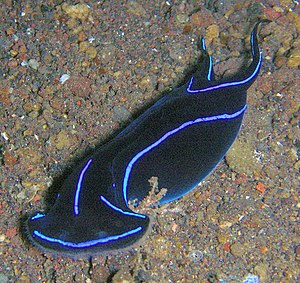Aglajidae
| Aglajidae | ||||||||||||
|---|---|---|---|---|---|---|---|---|---|---|---|---|

Chelidonura varians , head shield in front left |
||||||||||||
| Systematics | ||||||||||||
|
||||||||||||
| Scientific name | ||||||||||||
| Aglajidae | ||||||||||||
| Pilsbry , 1895 (1847) |
The Aglajidae are a family of exclusively marine snails in the order of the head shield snails (Cephalaspidea). The small to medium-sized hind gill snails that are widespread worldwide have a membranous inner shell. They feed on freely moving small animals, whereby the range of prey varies depending on the species.
features
The snails of the family Aglajidae have a rather soft and flabby body of an elongated, cylindrical shape, each side with a thin fold from which parapodia extend. The thin-walled snail shells of the Aglajidae, which often only have the shape of the upper quarter of a shell of a bladder snail ( bulla ), are enclosed in the rear part of the intestinal sac and are only partially exposed in a few species. In some species there are stretchable bristles on each side of the mouth that are used for foraging. Many species have a pair of long appendages at the rear end, the left of which is usually longer. With a few exceptions, the snails have neither a radula nor a gizzard with chewing plates.
Like other head snails, the Aglajidae are hermaphrodites that either mate each other with their penises or take on the role of male and female during sex, which can also be changed after the act has been completed. However, chains of copulation can also be formed by several animals lying on top of one another, in which the topmost only function as a male, the bottom only as a female and everyone in between functions as both males and females. The eggs are laid in egg capsules, grouped in clusters of different shapes, from which Veliger larvae usually hatch after a few days . The development cycle of most species is so far little known.
All known Aglajidae are carnivores , whereby unlike other head shield snails, freely moving prey animals are preferred. Depending on the type of snail, nudibranch snails , head shield snails, poly-bristles , nematodes , hookweed , foraminifera , mussels , woodlice , sea cucumbers and a goby were found in the intestines of predatory snails . The most diverse animal remains have been found in the genus Navanax , whose species are considered to be the fastest creeping sea slugs : sponges , scalp snails, nudibranchs, pancakes, new snails, annelids, crabs and fish. Aglaja felis , on the other hand, eats foraminifera. Chelidonura varians , on the other hand, as a food specialist, feeds on the Acoela species Convolutriloba retrogemma . The prey animals are actively sought and, given the mostly missing radula, swallowed whole with the help of the muscular pharynx . The eating process can take place in seconds.
Systematics
According to Bouchet and Rocroi (2005), the Aglajidae family is one of eight families in the Philinoidea superfamily . The family includes 14 genera:
- Aglaja Renier, 1807
- Biuve Zamora-Silva & Malaquias, 2017
- Camachoaglaja Zamora-Silva & Malaquias, 2017
- Chelidonura A. Adams, 1850
- Mannesia Zamora-Silva & Malaquias, 2017
- Mariaglaja Zamora-Silva & Malaquias, 2017
- Melanochlamys Cheeseman, 1881
- Nakamigawaia Kuroda & Habe, 1961
- Navanax Pilsbry, 1895
- Niparaya Zamora-Silva & Malaquias, 2017
- Odontoglaja Rudman, 1978
- Philinopsis Pease, 1860
- Spinoaglaja Ortea, Moro & Espinosa, 2007
- Tubulophilinopsis Zamora-Silva & Malaquias, 2017
literature
- Philippe Bouchet & Jean-Pierre Rocroi: Part 2. Working classification of the Gastropoda . Malacologia, 47: 239-283, Ann Arbor 2005 ISSN 0076-2997
- Winston Ponder & David Lindberg, Towards a phylogeny of gastropod molluscs; an analysis using morphological characters . Zoological Journal of the Linnean Society, 119: 83-265, London 1997 ISSN 0024-4082
Web links
Individual evidence
- ^ A b Robert Burn: Nudibranchs and Related Molluscs. Museum Victoria, Melbourne 2015. p. 49.
- ↑ Nils Anthesa, Nico K. Michiels: morphology Reproductive, mating behavior, and spawning ecology of cephalaspid sea slugs (Aglajidae and Gastropteridae). Invertebrate Biology 126 (4), pp. 335-365.
- ↑ Andrea Zamora-Silva, Manuel Malaquias (2016): Diet preferences of the Aglajidae: a family of cephalaspidean gastropod predators on tropical and temperate shores. Journal of the Marine Biological Association of the UK 96 (5), pp. 1101-1112.
- ↑ David W. Behrens: Nudibranch Behavior. New World Publications, Jacksonville (Florida) 2005, p. 99.
- ↑ Navanax inermis eats Hermissenda crassicornis ( Navanax inermis eats Hermissenda crassicornis , on Youtube)
- ↑ World Register of Marine Species , World Marine Mollusca database: Aglajidae Pilsbry, 1895 (1847)